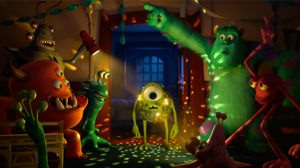I wonder if someone in your profession prefers to work on an animated film like_ Monsters University_, where your contribution is easier to understand.
Sound design has to be one of the great misunderstood arts of filmmaking. If you do your job right, no one knows you even touched the film; your design feels as natural as the world we re-enter after the credits roll. But you know better. Almost every sound accompanying the onscreen images is completely crafted. And yet, most people are unaware of the ingenious ways you recreate real world sounds with the most unlikely items. Watermelons hit with rubber hoses become punches to the head. Fresh celery broken in half is snapping bones. I don't want to know how you solved the challenges presented to you in Zack and Miri Make a Porno.
But even when you're working on an animated film - a prequel, no less - do you ever find yourself returning to the same bag of tricks? After 86 movies, are you still reusing your existing library of roars, screams, and crashes, or creating something new? I couldn't help but think of this while I watched Monsters University, but probably not for the reasons you think.
Yes, as a follow-up, there are plenty of callbacks to Monsters Inc., the 2001 film that introduced us to Mike Wazowski (Billy Crystal) and Sully (John Goodman). Those two, plus a few other familiar characters (like Steve Buscemi's slithery Randall Boggs, who I was particularly pleased to see), are training to harness children's screams in order to power, well, whatever that world they inhabit is called. It's not the familiarity of these elements that struck me, though. It was, instead, the film's structure: that of a 1980s-era college comedy. Revenge of the Nerds, to be specific.
An R-rated sex comedy might not seem like the obvious template for a G-rated family film, but it works surprisingly well. Taking the confident heroes from the first film and remaking them as the oddball campus castoffs is just enough to make things feel fresh. This approach also gives you a new palette to work with. Instead of the industrial soundscape of Monsters Inc., you're forced to ground things a little more in the real world to emphasize elements of a slapstick buddy comedy.
Hey, maybe all your work on Kevin Smith's projects prepared you more than I thought.
As happy as I was to watch Mike and Sully follow the college comedy blueprint – the stern dean (Helen Mirren) who takes an instant dislike to them, the jock fraternity who rejects them, the loser fraternity they're forced to join, etc. - I wasn't sure if children would understand this nod to a very specific sub-genre. But like Pixar's best films, Monsters University works just fine without that context. Director Dan Scalon relies on solid filmmaking, valuing character over "nudge-nudge, wink-wink" in-jokes to get his laughs.
The references children will connect with come from your sound design. And that's where Monsters University faltered a bit for me. In it's third act, when as the film comes closer to Monsters Inc.'s world of clanging portals and screaming humans, Monsters University starts to feel familiar in that been-there-done-that way. A revelation in Monsters University's denouement even, unfortunately, undermines the power of my favourite sound in the original: children's laughter.
Overall, though, Monsters University, like your sound design, takes something familiar and changes the context just enough so it feels like it was always meant to be that way.
Listening; always listening.
Casey







